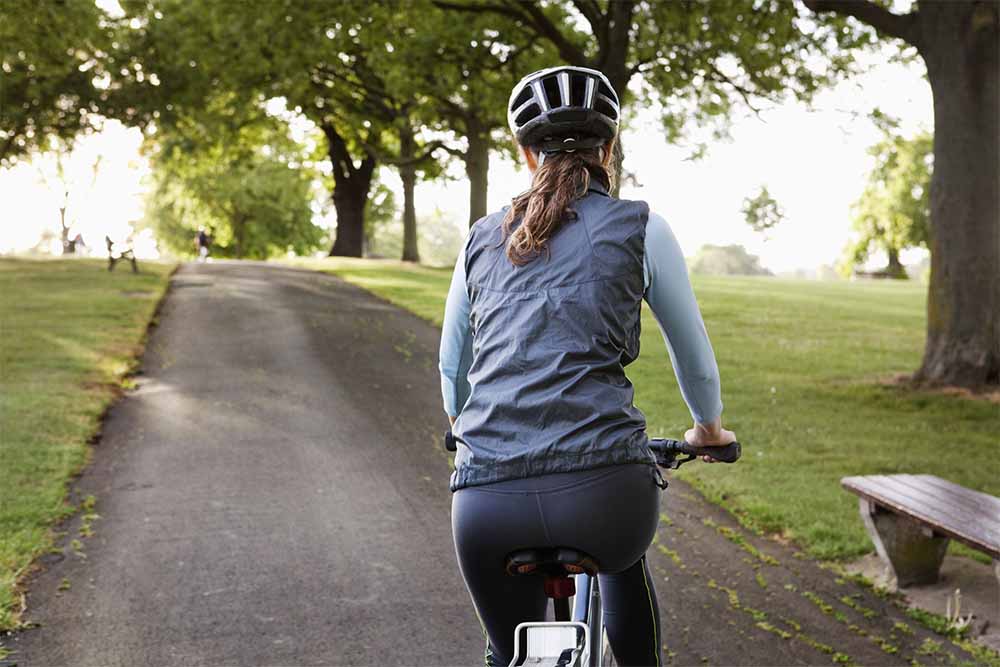Top 12 benefits of cycling, plus safety tips

Cycling is a low-impact cardio exercise that offers many benefits. It also varies in strength, so it is suitable for all levels. You can use your bike as a form of transportation, a leisure activity or a fierce competition. Cycling is a great form of exercise that will keep you energized. It can help shape a healthy lifestyle, both physically and mentally. Read on to learn about some of the ways cycling can improve your health and well-being. Accordingly, the article will tell you about benefits of cycling.
1. Cycling can help you lose weight
Habitual cycling, especially high-intensity cycling, can help reduce body fat levels, thereby promoting healthy weight management ( 1Trusted Source ).
Other research suggests that sprinting and strength training while cycling regularly may temporarily increase your metabolism and build muscle, allowing you to burn more calories even at rest ( 2 ).
2. Cycling helps strengthen your legs
Cycling improves the overall function of the lower body and strengthens the leg muscles without putting undue stress on the joints. It targets your quads, glutes, hamstrings and calves.
To strengthen your legs and improve your riding performance, try performing weightlifting exercises such as squats, leg presses, and lunges a few times a week ( 3Trusted Source ).
3. Cycling is good for beginners
Cycling is fairly simple. Stationary bikes are a great option if you have difficulty with standard bikes.
If you are new to fitness or recovering from an injury or illness, you can ride at a low intensity. As you get fitter, you can increase the intensity or continue riding at a cooler pace.
Research has shown that even sedentary people can reap health benefits from cycling, so it may be a good introduction for those who are new to the sport ( 1 ).
4. Cycling can lower cholesterol
The health-enhancing effects of cycling may help raise cholesterol levels, which can boost cardiovascular health and reduce the chance of stroke and heart attack.
Indoor cycling has a positive effect on total cholesterol, according to a review of 300 studies. It may raise HDL (good) cholesterol levels while lowering LDL (bad) cholesterol and triglyceride levels ( 4Trusted Source ).

5. Cycling boosts mental health and brain power
Cycling can relieve feelings of stress, depression or anxiety. Focusing on the road or your rhythm while cycling can help you develop focus and awareness of the present moment. This may help distract you from the mental chatter of the day.
Research supports this. One study found that cycling outdoors improved cognitive function and well-being in older adults ( 5Trusted Source ).
If you find yourself lethargic, lethargic, or your brain is slow, ride your bike for at least 10 minutes.
Exercise boosts the release of endorphins in your body, which help you feel better while lowering your stress levels. Outdoor exercise only increases these effects, as the above study found ( 5Trusted Source ).
Once you make cycling a part of your life, you may feel more confident and content.
6. Cycling can help cancer patients
If you have or are recovering from cancer, cycling is a great addition to your care plan. However, many cancer patients experience low energy and pain during treatment, so be sure to work with your care team, listen to your body, and only exercise when you’re ready.
Cycling can also help you stay slim and fit, which may lower your risk of certain types of cancer, including breast cancer ( 6Trusted Source ).
If you have breast cancer, staying active may help reduce side effects of cancer treatment, including fatigue, and improve your overall quality of life, according to 2019 research ( 7Trusted Source ).
7. Cycling can give your morning a positive start
Starting your day with a healthy activity like cycling can wake you up by boosting your circulation and give you a sense of accomplishment.
Over time, you may be more inclined to make healthy, positive choices ( 8 ).
Low-intensity, fasting morning rides can burn fat, enhance endurance performance, and boost your energy and metabolism levels throughout the day ( 9Trusted Source ).
warn? Research seems to suggest that this applies mostly to recreational cyclists, and trained athletes are not advised to hurry up before long endurance rides ( 9Trusted Source ).
8. Cycling may help prevent and manage disease
Whether you’re trying to prevent health problems or manage existing conditions, regular exercise is key. Cycling on a regular basis is one way to avoid a sedentary lifestyle and the health problems it can accompany.
Regular exercise can help prevent heart disease, such as stroke, heart attack, and high blood pressure ( 10Trusted Source , 11Trusted Source , 12Trusted Source ).
Cycling may also help prevent and manage type 2 diabetes ( 13Trusted Source ).
In fact, recent studies have shown that regular cycling can reduce mortality by 24% in people with diabetes, and by 35% if continued for at least 5 years. 14Trusted Source).

9. Cycling is environmentally friendly
Cycling as much as possible to reduce your carbon footprint. A recent study in Europe found that cycling once a day instead of a car commute can reduce your transportation carbon footprint by 67% ( 15 ).
Cycling is a great alternative to transportation that requires sitting in traffic for long periods of time. It’s especially useful when you’re going somewhere too far and you don’t want to drive.
One benefit is not having to fight for parking spaces in crowded areas.
10. Cycling improves balance, posture and coordination
When you stabilize your body and keep your bike upright, you’ll improve your overall balance and coordination, and even your gait ( 16Trusted Source , 17Trusted Source ).
Balance tends to decline with age and inactivity, so maintaining it is critical. Improving your balance can help prevent falls and fractures, which can help reduce your risk of injury and keep you off the sidelines.
11. Cycling is a low-impact option
Cycling is easy on your body, providing a gentle, low-impact option for those who want to perform vigorous exercise without stressing their joints ( 18 ).
Cycling is a great option for people with joint problems or overall stiffness, especially in the lower body.
12. Cycling may reduce the risk of cardiovascular disease
Cycling is an excellent way to increase your heart rate, improve cardiovascular function, and improve your overall fitness.
A 2019 review found that cycling was associated with a lower risk of cardiovascular disease. It is also associated with lower mortality and a lower incidence of physiological risk factors, such as diabetes, physical inactivity, and high blood pressure ( 19Trusted Source ).
Disadvantages and Safety of Cycling
Cycling has some disadvantages to consider. These mostly apply to outdoor riding, which involves variables beyond your control.
A serious disadvantage is the risk of accidents, whether in urban or rural areas. According to the U.S. Department of Transportation, 726 cyclists were accidentally killed and 50,000 injured in 2014 alone (20).
If possible, ride in lanes reserved for cyclists or nearby streets.
Several studies have shown that bike lanes and streets within 550 meters have fewer cyclist-vehicle collisions ( 21 ).
Always obey traffic laws. Be careful when crossing intersections and busy areas, even if you have the right of way. Buy a quality helmet and any other protective gear you might need.
Avoid wearing any loose clothing that could get caught in the bicycle chain. Use bike lights and reflective gear for nighttime rides or early morning rides before the sun rises.
If cycling to work is a long way, consider a change of clothes to freshen up.
Bad weather can also be a hindrance. On days when you can’t ride outdoors, you can ride a stationary bike or choose another activity.
If biking is your mode of transportation, invest in rain and cold-weather gear and have a backup transportation plan in case it’s not safe.
For long day rides, use sunscreen on all exposed skin. Reapply every 2 hours, especially if you are sweating. Wear UV-blocking sunglasses and a hat. Consider investing in UV protection clothing.
Air pollution is another issue if you are cycling in the city. You can choose to cycle on days with cleaner air or on less crowded roads.
It’s okay to ride a bike every day, especially if you use your bike for transportation or ride at a low intensity.
If you feel pain, fatigue, or muscle soreness, take a break.
If you ride a bike for fitness, you may want to rest yourself at least 1 day a week, especially if you’re riding longer or at a higher intensity. Exercise scientists agree that recovery is necessary to prevent injury and improve performance ( 22 ).
This is especially important if you ride at a high intensity or find that your body is sore in a specific way.
who shouldn’t ride a bike
If you have any injuries that cycling affects, it is best not to ride until you are fully recovered.
Consult your doctor if you have any conditions that cycling may affect. People who are concerned about balance, vision or hearing may prefer stationary or adaptive bikes.
If you don’t want to ride a bike but want your body to do a similar cardio workout, choose rowing, stair climbing, or an elliptical machine. You can also run, swim or walk.
bottom line
Cycling is an enjoyable way to stay healthy and connect with the world around you.
If the weather is in your favor, get on your bike and go farther. Cycling is a great way to explore the area. It overcomes the boredom that repetitive exercise can bring.
Please stay safe and exercise caution when necessary, especially on busy roads or in bad weather.
When the weather is not conducive to outdoor riding, indoor riding is a great option with less risk and many health benefits.
No matter which way you ride your bike, you can enjoy the satisfaction that comes with improving your fitness while having fun.
If you are looking for a new way of commuting or want a healthier lifestyle, we are here to help you. Visit our website to learn more about electric bikes and electric scooter or please leave information to us.
 Shuangye ebike
Shuangye ebike
